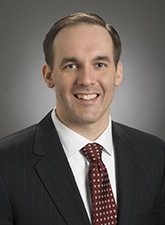Part of a series on the chiropractic residency program in the VA health care system
The blog posts in the VA Chiropractic Residencies series thus far have been focused solely on the current residents’ experiences as they unfold throughout the year. For many, the question remains: What happens after the residency ends? In this post, I summarize what Brian Giuliani, DC, the 2016 graduate of the VA Connecticut Healthcare System, and Kelsey Corcoran, DC, the 2017 graduate of the VA of Western New York Healthcare System, learned from their respective programs, their favorite rotations, where they are now, and what advice they have for students interested in applying for the VA Chiropractic Residency.
Brian Giuliani, DC
Dr. Giuliani, an alumnus of New York Chiropractic College, is currently practicing with the Aurora Spine Institute, a subset of the larger Aurora Healthcare Hospital System, in Sheboygan, Wis. His clinic is comprised of an orthopedic spine surgeon, surgical PA, physiatrist, two spine-specific physical therapists, three chiropractors, and multiple anesthesiologists who perform interventional procedures. In the chiropractic department, Dr. Giuliani primarily treats patients with non-operative musculoskeletal conditions of the neck and low back (with and without radiculopathy) and headache. 
The opportunity to train under experienced clinicians during the residency helped bridge the gap between classroom medicine and clinical medicine, according to Dr. Giuliani, resulting in proper application of the knowledge he acquired throughout his schooling. Additionally, he found the program rapidly exposed his clinical deficiencies and afforded him time and guidance to positively augment these areas. The clinical training, in his opinion, is the greatest strength of the residency, with development of interpersonal communication skills coming in a close second. These communication skills are developed by observing the attending chiropractic physician’s interactions with patients, as well as on rotation while working under other medical specialties.
Neurosurgery topped Dr. Giuliani’s list when it came to rotations. Taking place near the end of the year-long program, it was viewed somewhat as a capstone course. Application of the vast knowledge he gained over the year gave rise to competently performing consultations, planning both operative and non-operative strategies, and first-hand learning of some surgical aspects in the operating room. Additionally, he found physiatry and pain management to be valuable as they exposed him to a broad spectrum of musculoskeletal cases not generally seen in VA chiropractic clinics as well as increased his ability to synthesize large amounts of information into a novel management plan.
Dr. Giuliani advises interested students to look at the residency program from an educational perspective, rather than one focused on job security. “You should have an idea of where you want your career to take you, whether that is education, research, administration, etc. You will be presented with an opportunity that few in our profession have…if you approach it as an education opportunity, you will do very well.”
Kelsey Corcoran, DC
Kelsey Corcoran, DC, fellow University of Western States alumnus, worked under site director Andrew Dunn, DC, MEd, MS, in Buffalo, N.Y. Currently, Dr. Corcoran is a postdoctoral fellow of medical informatics at the Yale School of Medicine. This two-year fellowship is in association with the VA Connecticut Healthcare System and made possible by funding from the NCMIC Foundation. Her postdoctoral fellowship is unique as it focuses on medical informatics projects for administrative and research purposes. Gaining a better understanding of nonpharmaceutical pain management for veterans is central to Dr. Corcoran’s work, and allows her the opportunity to work with many different departments. These departments include the Yale Center for Medical Informatics, VA Chiropractic Services, Clinical Informatics at VA Connecticut, and the Pain Research, Informatics, Multi-morbidities, and Education (PRIME) Center at the VA in West Haven, Conn. Dr. Corcoran also completes coursework at Yale as a component of her medical informatics training.
While Dr. Corcoran was a chiropractic resident in Buffalo, she found primary care to be her most noteworthy rotation. She felt it enhanced her understanding of where chiropractic referrals were originating and the challenges facing physicians who are typically responsible for managing multiple comorbid conditions for each patient.
Ultimately, she advises those seeking to complete a residency program to start by taking advantage of the VA clerkship opportunities offered during clinical training in school, if your school has an affiliate. Even if it requires moving for a few months, she notes the experience gained will likely be well worth the short-term inconvenience of relocating. Additionally, she emphasizes the weight your recommendation letters have on the application process. Dr. Corcoran suggests that students “find three strong letter writers…having a friend who recently graduated from chiropractic school write you a letter is usually obvious and not recommended.”
Although most people may view the VA Chiropractic Residency as a means to gain employment within the VA system, there are more opportunities available to residency graduates outside that realm. The residency program allows for comprehensive clinical training in a multi-disciplinary setting, which results in preparedness and competence to pursue opportunities in a private hospital or postdoctoral fellowship.
Dr. Halloran is the chiropractic resident with the VA Connecticut Healthcare System under site director, Anthony Lisi, DC, and concurrently working towards her Master of Science in Human Nutrition and Functional Medicine through the University of Western States (UWS) as well as her diplomate in Diagnosis and Internal Disorders through the ACA. Dr. Halloran’s professional interests include advocacy and toxic exposure, nutritional deficiencies and chronic musculoskeletal pain within the veteran population.
Related News: Congress passed legislation on March 23, 2018, that will expand access to chiropractic services for veterans who receive care through the VA health care system. Learn more.
